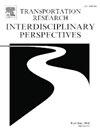A naturalistic study into the flow of alighting and boarding passengers of commuter trains
IF 3.9
Q2 TRANSPORTATION
Transportation Research Interdisciplinary Perspectives
Pub Date : 2025-03-25
DOI:10.1016/j.trip.2025.101369
引用次数: 0
Abstract
The alighting and boarding times of commuter trains play a major role for the length of dwell times and are directly influenced by the flow rate of both alighting and boarding passengers, measured as the number of passengers passing through a door per second. It is, therefore, important to have a good understanding of passenger flow rates to better understand and schedule dwell times. Where previous studies into passenger flow rates have mostly taken place in mock-up settings, this study focuses on the flow rate of alighting and boarding passengers in a real-world setting. Using video footage of more than one thousand alighting and boarding processes we find that the flow rate of alighting passengers increases with an increase in the volume of passengers but only up to a saturation point, whilst the boarding flow rate remains stable. The dominant flow of passengers is found to have a statistically significant effect on the flow rates of alighting and, especially, boarding passengers. These effects are found across different passenger volumes. Both alighting and boarding flow rates are affected when passengers carry luggage, whereas the presence of bicycles did not have a statistically significant effect on alighting flow rates. The findings presented in this paper suggest that different flow rates should be used when modelling dwell times depending on the number of passengers, that a saturation point for the alighting flow rates exists, and that boarding flow rates are likely more affected by other factors such as interior bottlenecks than passenger volumes.
通勤列车上下乘客流动的自然主义研究
通勤列车的下车和上车时间对停留时间长短起着重要作用,并直接受到下车和上车旅客流量(以每秒通过一扇门的旅客数量来衡量)的影响。因此,了解客流率对更好地理解和安排停留时间是很重要的。以往对客流率的研究大多是在模拟环境中进行的,而本研究关注的是现实环境中乘客上下车的流量。通过对一千多个上下飞机过程的录像记录,我们发现下飞机的旅客流量随着客流量的增加而增加,但只会达到饱和点,而上飞机的旅客流量则保持稳定。研究发现,优势客流对下飞机客流率,尤其是登机客流率有统计学上显著的影响。这些影响是在不同的客运量上发现的。当乘客携带行李时,下车和上车流量都受到影响,而自行车的存在对下车流量没有统计学上的显著影响。本文的研究结果表明,在对停留时间进行建模时,应根据乘客数量使用不同的流量,下车流量存在饱和点,而登机流量可能更受内部瓶颈等其他因素的影响,而不是客运量。
本文章由计算机程序翻译,如有差异,请以英文原文为准。
求助全文
约1分钟内获得全文
求助全文
来源期刊

Transportation Research Interdisciplinary Perspectives
Engineering-Automotive Engineering
CiteScore
12.90
自引率
0.00%
发文量
185
审稿时长
22 weeks
 求助内容:
求助内容: 应助结果提醒方式:
应助结果提醒方式:


